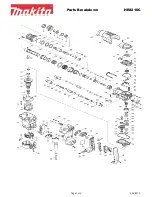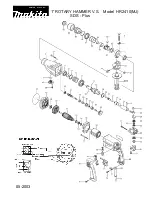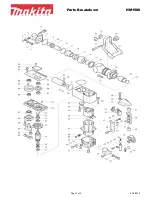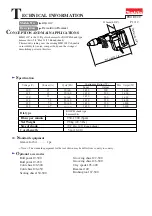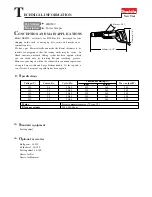
• For practical purposes, one should use
one limit stop for each type of milling
work. There are different possibilities for
this, so only the most practical are ex-
plained here:
7.5.2 Milling with limit stops
7.5.2.1 Milling with parallel limit
stops
(Limit stop is included in the scope of deliv-
ery, see fig. 7a, b)
As suggested by its name, you can use the
parallel limit stop to fabricate grooves that
are parallel to the work piece edge, as illus-
trated in fig. 7a. To do so, the supplied par-
allel limit stop must be mounted and adjust-
ed (see fig. 7b regarding this):
1. As in the illustration, push both guide
bars (2) into bores 3 in limit stop 1 and
firmly tighten both headless screws (4)
with the aid of a hollow hexagon wrench.
2. Press the limit stop with both guide bars
in the form as shown in the illustration in-
to both bores in base plate 5 and push it
up to the desired distance (6).
3. Tightly clamp the limit stop with both
thumbscrews (7)
You can now mill as shown in illustration 7a.
Pay attention to the feed direction: The
cutter must always be able to work in the
opposing direction! (See Fig. 6 and 7.5.1.:
General information about milling). If this is
not the case, the limit stop must be moun-
ted on the opposite side.
7.5.2.2 Milling with the circular limit
stop.
(Circular stop is included in the scope of de-
livery, see fig. 8a, b)
With the circular limit stop, you can mill out
in circles or circle segments, as shown in il-
lustration 8a. First, the limit stop needs to be
mounted using the pin. To do so, proceed as
described in the previous point 7.1.1.
„Milling with parallel limit stops“ about
mounting the parallel limit stop, but of
course use the circular limit stop instead of
the parallel one:
1. As in illustration 8a, push both guide bars
(2) into bores 3 in limit stop 1 using the
pin, and firmly tighten both headless
screws (4) with the aid of a hollow hexa-
gon wrench.
2. Press limit stop 1 with both guide bars (2)
in the form as shown in the illustration
into both bores in base plate 5 and push
it up to the desired distance (6). Please
note: The radius of the desired circle is
the distance of the pin to the mill cutter
router bit axis!
3. Tightly clamp the limit stop with both
thumbscrews (7)
4. Push the pin onto the previously marked
position of the circle or circle-segment
center
5. Switch on the mill and trace circles or
arcs with the mill cutter.
CAUTION:
When milling, keep the pin of the limit stop
pressed down a bit (fig. 8a)!
7.5.3 Additional information on
milling with limit stops
7.5.3.1 Milling with longitudinal stops
(fig. 9)
In cases where the traversing distance of the
parallel limit stop is not sufficient for straight
milled grooves, you can make a longitudinal
stop by yourself quickly and easily. Simply
tightly clamp a straight strip, straight board,
etc. using C-clamps to the position on the
work piece as needed. Then the outer edge
of the device foot can trace the edge of the
limit stop and the milled groove can be man-
ufactured. Please ensure enough clearance
between the device foot-edge and the mill:
of course, you must take this accordingly in-
to consideration when positioning the limit-
stop strip, the limit-stop board, etc.
7.5.3.2 Milling with simple master
forms (fig. 10)
To mill simple, irregular contours, it is rec-
ommended to fabricate a template: The de-
sired contours can be placed into a ca.
3
/
8
” /
10 mm thick board or similar and used as a
limit stop.
14




















